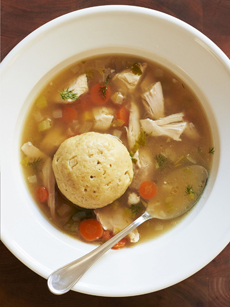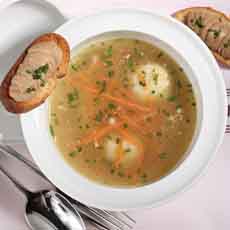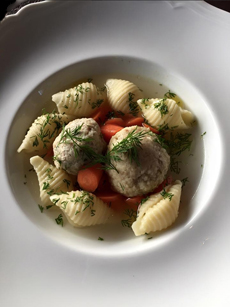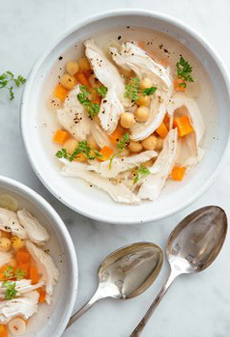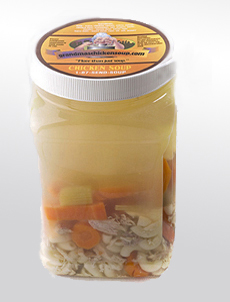RECIPE: Jewish Chicken & Matzoh Ball Soup Soup
|
In the 1970s, one of the most beloved subway advertising campaigns in New York City was, “You don’t have to be Jewish to love Levy’s real Jewish rye.” Each poster or print ad in the campaign featured African-Americans, Asians, choir boys Irish cops, Italian grandmothers and WASPs, enjoying a slice of the rye bread (see photo #4 below). The pitch was successful in getting non-Jews to buy—and become fans of—the style of rye bread loved by the Jewish community: a light rye bread with caraway seeds.* It was so popular, that some 45 years later, it is referenced by advertising professionals, professors, journalists and consumers. You can purchase full-size posters of your favorites from AllPosters.com). We’d like to adapt the rye bread campaign to chicken soup. While Campbell’s chicken noodle soup is the #1 canned soup in the U.S., often tied with Maruchan chicken ramen noodle soup, in our humble opinion there’s nothing like Jewish chicken soup. The latter is not easily found in cans, except for Manischewitz Matzo[h] Balls in Chicken Broth, which we assure you, can’t hold a candle to the recipe below. So our tip of the day is: Step beyond your usual chicken soup and go for the gold. Make the soup a day in advance so the flavors can meld. We increase the amount of vegetables to enjoy larger portions of them in our soup. Ingredients For 4-6 Servings *Food trivia: Dark, unseeded rye bread is called pumpernickel. It is made from coarse rye flour and has a very long baking period, which gives the bread its characteristic dark color. †Removing the skin cuts down on much of the fat, which most people have to skim off later. Also, boiled chicken skin is not a particular treat. ‡We often tie a half bunch of dill and a half bunch of parsley with kitchen string and add them to the pot. We pull them out when the soup is done, and then use the rest of the dill and parsley to snip onto the bowls of soup as a garnish. 1. ADD the water to a 6-quart pot, filled by the other ingredients. Bring to a boil, skim any foam, reduce heat and simmer, covered, for 3 hours. Taste and adjust seasonings. 2. REMOVE the cooked chicken from the pot and cut off the bone. You can shred it or slice it, as you prefer. Refrigerate. 3. MAKE the matzoh balls per the recipe below (you can also do this a day in advance). We were brought up with light-as-a-feather, soft matzoh balls. Our mother referred to firm matzoh balls as rocks. But it’s a matter of preference. If you only have one large pot, make the matzoh balls first. You can store them in another container in the fridge, and the pot will be free to make the soup. |
|
|
|
________________ ‡‡Some cooks add onion salt or garlic salt. We don’t like them in our matzoh balls, although we’ve personally added ground chipotle (although most guests opted for the fresh-herbs-only version). |
||
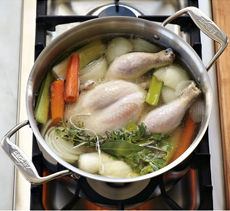 [5] Chicken in the pot refers to an entire chicken cooked with the same ingredients as chicken soup (photo of AllClad stock pot © Williams-Sonoma).
|
Ingredients For Firm Matzoh Balls Use the above ingredients and: 1. LIGHTLY BEAT the eggs and add the remaining ingredients until well blended. Do not over-mix or you’ll get tough matzoh balls. Cover and chill for 45 minutes to 1 hour to set. Meanwhile… 2. BRING a 6-quart pot of salted water (1 tablespoon salt per 4 quarts water) to a boil. Scoop rounded tablespoons of the matzoh ball dough into 1-1/2-inch balls—larger as desired, but two smaller matzoh balls are easier to slice and eat in the soup. (We use a cookie dough scoop; Mom formed hers by hand.) Add to the water, one at a time, with a slotted spoon. When all the matzoh balls are floating on the top… 3. LOWER the heat to a rolling simmer for 40 minutes. AVOID the temptation to stir! Remove with a slotted spoon and place in a serving dish. 3. STORE in the fridge. An hour or two before serving, bring them to room temperature and warm them in the pot of soup. While we love classic Jewish chicken soup and eat it often, we also like to have fun by varying or adding ingredients. For example: |
|
|
RECIPE #3: GRIBENES The by-product of rendering chicken skin for fat (schmaltz) are cracklings: crispy pieces of chicken skin. They’re a prized treat to eat on potatoes or anything else. In Yiddish they’re called gribenes (GRIH-beh-ness) or grieven (GREE-vin), which means “scraps” in Hebrew. When a whole chicken is being used for soup and the skin isn’t needed (it just adds fat that needs to be skimmed off later), it can be cut into strips for gribenes. Cooked with sliced onions, the result is memorable. Ready to render? Ingredients For 1/2 Cup 1. COMBINE the chicken fat and any skin in a small saucepan, along with the thyme, garlic and water. Bring the mixture to a simmer over medium-low heat. 2. COOK until the fat has rendered (liquefied) and the skin pieces are crispy, about 35 to 45 minutes. As liquid fat fills the pan, drain it into a measuring cup or other vessel; the gribenes will take longer to get crisp. 3. EAT the gribenes as soon as possible after they come out of the pan. Don’t refrigerate; they’ll go limp. These delicious cracklings can be eaten with potatoes, garnish a salad or chicken/turkey sandwich, grits or polenta, etc. Both Nana and Mom ate them straight from the pan. 4. COOL the chicken fat slightly, then strain it into a lidded jar. It will keep for up to one week, maybe longer. CHECK OUT WHAT’S HAPPENING ON OUR HOME PAGE, THENIBBLE.COM.
|
||
